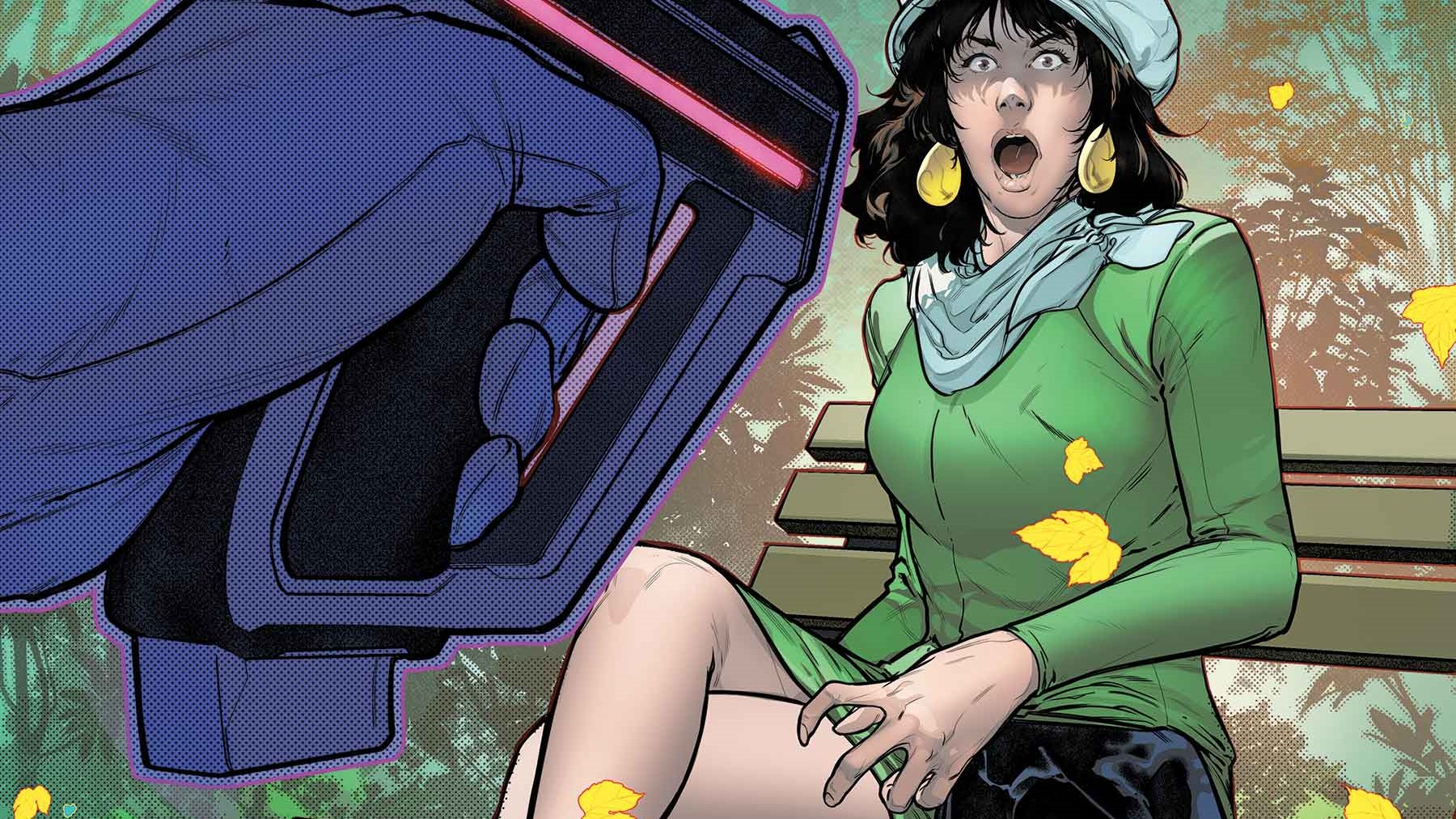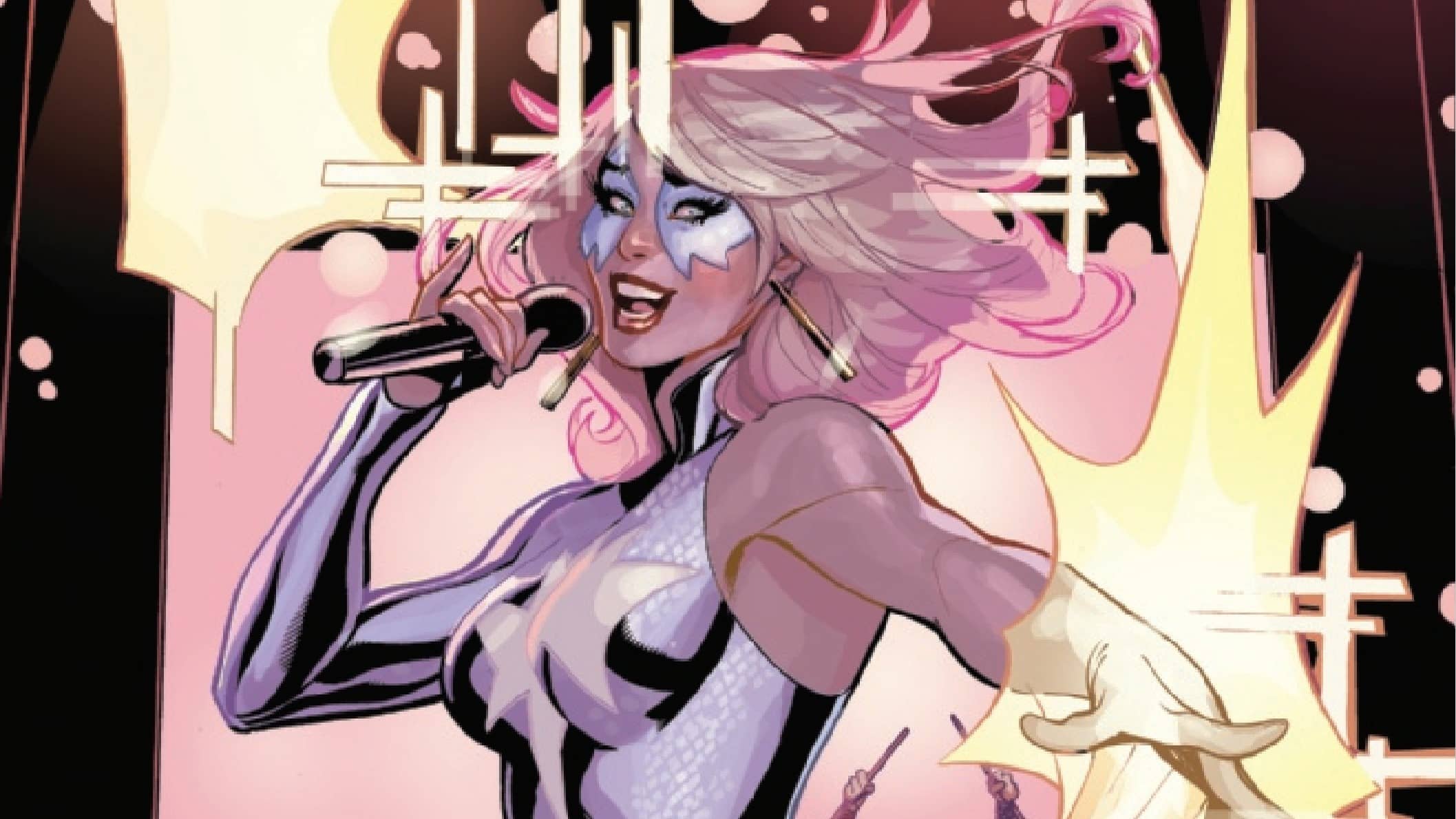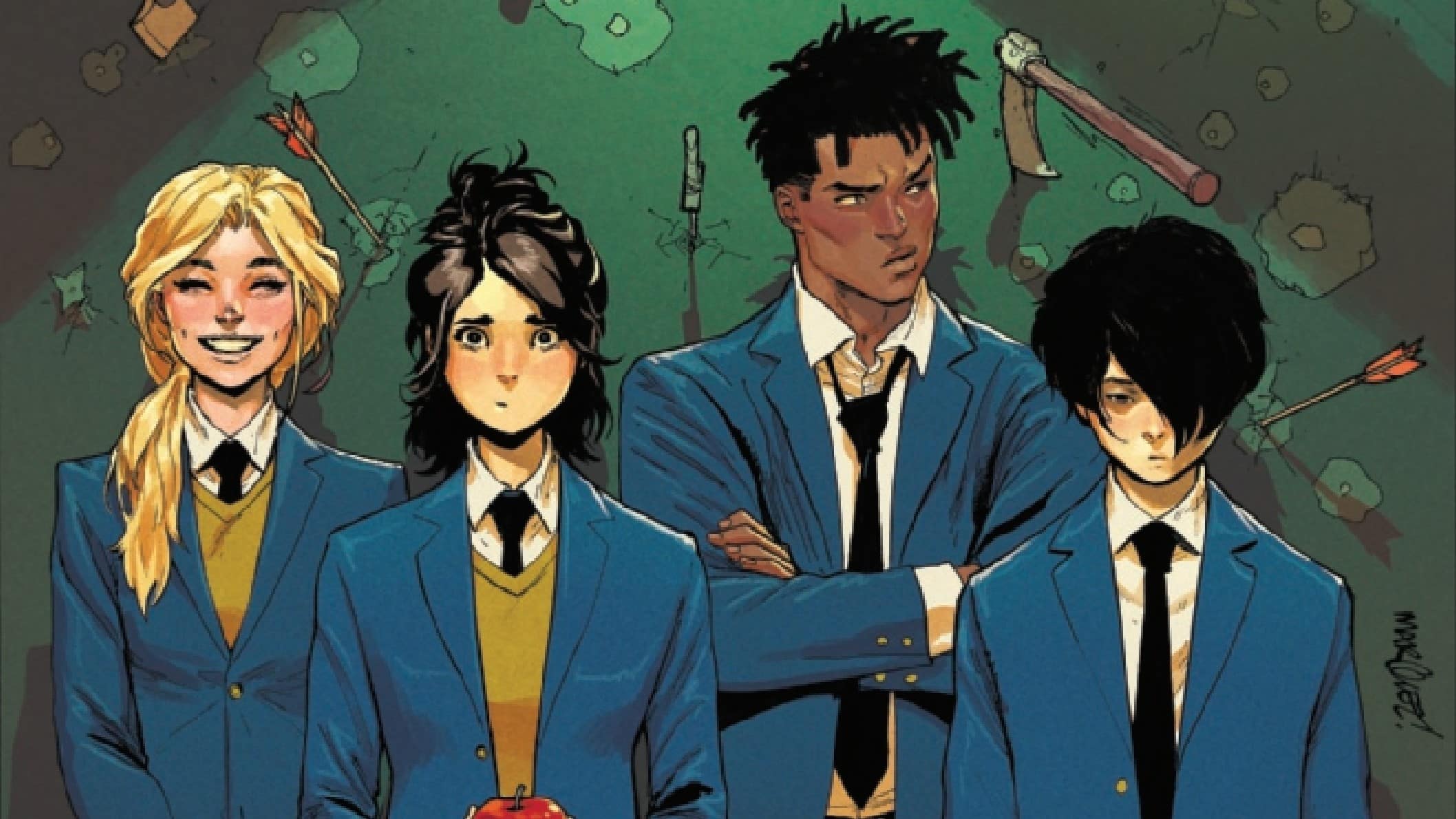The past, present and future of Krakoa all rest in a trigger finger. The scenario you prayed would never happen plays out as two series that are one move toward a crash that will reverberate outside the universe in Rise of the Powers of X #3, written by Kieron Gillen, drawn by R.B. Silva, colored by David Curiel and lettered by Clayton Cowles.
Jake Murray: Well, Austin, the gears of the machine sentience are really starting to click in preparation for ascendance in this series. The way this issue combines cosmic-scale conflict with intimate heartache was really impressive, and Silva and Gillen combined to great effect to achieve this. Not only did it drive forward the sci-fi plot of the Krakoa era, but it was a wonderful character study of the two central figures who birthed the dream back in House of X #2. This issue parallels Xavier and Moira beautifully, and emphasizes just how much they’ve changed since they first met on that bench all those years ago.
Austin Gorton: Fall of the House of X has, thus far, been a lot of noise more so than a poignant restatement and wrap-up of the themes of the Krakoa era, but Gillen is doing a yeoman’s work on that front more or less by himself. The way Rise of the Powers of X #3 manages to somehow be, as you say, both a quiet presentation of how far Charles and Moira have come and a big, bonkers sci-fi adventure is pretty damn impressive.
Jake: It really is, and having R.B. Silva on board doesn’t half help for the feeling of consistency and recapturing the poignancy of Powers of X. I suspect we’re going to gush a lot about Silva’s art throughout our discussion, but the inventiveness he brings to the key moments in this story is truly a sight to behold.
The Cosmic Bench

Jake: The issue begins with salt, porridge and the beginning of Moira X’s 10th and current life. Gillen’s narrative captions explain how cautious she has been in her formative years before her mutant power and ability to reset the timeline have manifested. The disconnect between Silva’s panels portraying an innocent domestic scene with her mother and the maturity and the paranoia of her internal monologue is immediately striking. It sharpens the focus on Moira’s calculating side, but she retains her idealism and appears to be looking forward to the “something new” of “Xavier, Magneto, together. Mutant solidarity.”
Austin: I would love to see more of the increasingly-more-knowledgeable preteen Moira through her lives. What’s it like for 3-year-old Moira with all that knowledge in her head?
Jake: Moira bustles down the hill into the meadow, signifying the hope of a new start, but the Charles she finds is very different from the strong, smiling man sitting “under parted skies and brilliant sun” in House of X. The scene is equally beautiful, but David Curiel’s brilliant purples and electric blues contrast dramatically with Marte Gracia’s muted greens and browns in House of X, signifying that nature itself has become infected by the pain that awaits in the future. It has had a similar effect on the man she finds here; back turned and shoulders slumped, this is not the man she once pinned her hopes on. He is defeated and desperate, unable to look at her, while the look of utter shock on Moira’s face conveys a youthful innocence that belies the depth of her knowledge. Her dream, in a single moment, is dead. Silva achieves all of this in three pages.
Austin: The body language work alone is so impressive — Charles is slumped, his shoulders sagging, dragged down by the weight of the events of the last X years. Even when he turns on Moira, gun drawn, there’s a reluctance to it. It’s clear, just from the way Silva draws him, that while this represents the moment Xavier and his team have been working toward from the No-Place, it is not a moment of triumph for him.
Jake: The second scene between Xavier and younger Moira is even more beautiful. Silva is choreographing a dance, as Moira skips through the flowers and around Xavier pointing his gun at her. She tries to play the innocent, her childlike facial expressions again contrasting her skillful negotiation for her life and her grand designs for the universe. Gillen’s character arc for Xavier after the Hellfire Gala appears to be reaching its logical conclusion, as a humbled and guilt-ridden man seeks to atone for his sins no matter the cost. Charles’ life has been to an extent defined by compromise, and he faces another here: to be part of a family or to be loved, his morality, his identity, his life for his dream.
Austin: “Compromise” and Xavier’s relationship with it are key to this issue, here and later (and arguably, his entire Krakoa arc). Xavier had to compromise his dream to build Krakoa, he had to compromise with the likes of Sinister to keep it going, and now he’s compromising his morals to bring it all crashing down and defeat Moira and Orchis once and for all.
Jake: The final panel of the scene is chilling as everything fades to silhouette, Charles standing over a teenage girl in an execution pose as the bright light of the future bursts forth. He is no longer himself but a simulacra of Charles Xavier, the “curator of the dream.” Moira is not the only one about to die here.
But X-Men is nothing if not a soap opera, and one of the golden rules of the genre is that the longer someone holds the gun, the less likely they are to shoot. Inevitably, when we encounter Xavier and Moira for the third time, he’s lost his nerve. What do you think drives Xavier’s decision to let Moira live here?
Austin: In general, I think it’s that compromise thing again — finally, Xavier has reached a point where he won’t compromise his morals further. More specifically, I suspect we may see more of this moment over in Dead X-Men, as Rachel seemingly telepathically links her team with Xavier, and something they say gets through to him in terms of reaching that point. Crossover synergy strikes again!
There’s also the question of what Xavier does/says to Moira once he decides not to kill her. He clearly communicates something to her telepathically, but then says she will forget the details of this encounter (to preserve the timeline). So did he leave some kind of post-hypnotic suggestion? Some kind of abstract thought he can leave in place while removing all the other details of this encounter as a backup plan to his backup plan?
Jake: I definitely read it as Charles planting some kind of psychic failsafe that’ll come into play during the moment of ascension. I think there’s a bit of a clue on the panel that captures the moment of the mindwipe where Moira’s eyes go yellow, which mirrors the moment after Moira’s deal with Enigma is sealed and she warps through reality.
A Deal with God

Jake: In the present, meanwhile, Moira finally gets a chance to place her bet with the heavy favorite. She and Enigma parlay, but the odds are massively stacked against her.
Austin: Again, the creative team knocks it out of the park here, finding ways to make what is essentially a conversation between two people (people-ish) visually exciting, by having Enigma communicating with Moira via wisps of flame or discarded scraps of paper or a full page of, essentially, text messages. I also appreciate how Gillen writes Enigma; he’s not quite Sinister, but there are shades of Gillen’s Sinister in the dialogue, which underscores the relationship between them and reinforces the notion that Enigma is Sinister’s forebear.
Jake: Gillen draws surface-level parallels between Xavier and Moira in this issue while setting up a sharp contrast to pay off later. When Charles lets Moira go, he appears to be appealing to Moira’s last shred of humanity by letting her live. He does compromise his original plan, but rather than placing his faith in humanity one last time, he seeds a backup plan. Moira of the future strikes a precarious compromise of her own when she provides Enigma with access to all of her lives in exchange for her own independent and sentient place in his Dominion. While she is undeniably of value to him, the risk is all hers, something someone so used to having control is wholly uncomfortable with but must reckon with in the end. She must hope that enough of Nathaniel Essex’s already limited humanity still exists within Enigma, and take a leap of faith to secure her future. Charles might be counting on it.
Austin: In the same way that the Xavier/Moira scene called back to House of X #2, all this Moira/Enigma stuff reminds us of the original Powers of X; we even get another reminder of the relationship between worldminds, titans and dominions. There are obviously plot-based reasons for this, but it adds to the “back where it all started” feel of the issue.
We also get an answer to a long-running Krakoa era mystery, with the reveal that Enigma is responsible for shunting Omega Sentinel’s alternate future consciousness into the present, overriding her existing mind — a reveal that presumably will tie into the climax of the series, as Enigma gloats that with Phoenix dead, what happened to Omega Sentinel before can’t happen again.
Which, of course, carries us into the finale of Rise of the Powers of X #3, as Xavier sets about implementing Plan B.
Discord on No-Space

Jake: The part of the issue that didn’t work as brilliantly for me, and hasn’t generally in the series so far, is the Sinister crew on board the No-Place ship. It’s not so much that Rasputin finding out that Doug has been Sinister-ized precipitating the rapid unravelling of mission harmony doesn’t work as a story beat, because it does. Gillen has been seeding this throughout the series. It’s more that between this and X-Men Forever, it’s becoming a little predictable. There needed to be a catalyst for Xavier’s epiphany, and this gets us there. I think it’s more Sinister fatigue on my part.
Austin: It was genuinely surprising to see Xavier finally stop compromising for the sake of Sinister and let Rasputin put an end(?) to him once and for all. If anything, that may be what the repetition was meant to set up: Again and again, we’ve seen Xavier excuse Sinister in the name of the greater good, something that was reiterated just last week in X-Men Forever #1. Thus, when Rasputin first charges Sinister and Xavier stops her, we’re primed to expect a repeat again. Yet this time — finally — Xavier has had enough.
What I also really enjoyed about that beat is that the motivation for it is still a little murky. Was this Xavier acting out of his newfound sense of moral clarity, the same clarity that caused him to spare Moira? Or was this simply a more pragmatic move: Having punted on Sinister’s plan, does Xavier realize he needs Sinister out of the picture in order for the backup plan to work (and not get mucked up by Sinister)?
Because, of course, the NEXT thing Xavier does, after giving Rasputin the go-ahead to eliminate Sinister, is shoot Rachel with the same gun he was going to use on Moira.
Jake: I suspect we might have the answers to both of these mysteries by the time the next issue of this series comes out, which I’m still not sure how I feel about, but let’s stick with this issue for now because what an ending!
There’s a lot at play here, some elements we know and some we don’t. We know for example that Mother Righteous’ initial plan to achieve Dominion was to sacrifice Jean Grey and use the Phoenix to fuel her ascension. We also know that the Phoenix can kill a Dominion. We think we know that the Phoenix can’t die, but we’ve seen it having doubts in Immortal X-Men #17. I honestly couldn’t tell you how a dead Rachel and a dying Jean complete this particular equation, but I can’t wait to find out.
Inside the RoPoX Tox Box
- We told you the end of Krakoa wasn’t going to come via Xavier killing/depowering Moira.
- Sinister fatigue aside, the Madrox-infused Sinister ghosts Charles produces are cool as hell and absolutely terrifying.
- Now that Sinister Doug has been dispensed with, can we get the real Doug Ramsey back, please?
- It’s still not entirely clear (to me, at least) how Phoenix is dead at the moment (unless they’re talking about Jean specifically), but both Enigma and Xavier are pretty certain she/it is.
- Rasputin killing Sinister after all this time (including at least one overlong crossover) was quite cathartic. Not that I want (or expect) this to be the last we see of the mad Victorian scientist.
Buy Rise of the Powers of X #3 here. (Disclaimer: As an Amazon Associate, ComicsXF may earn from qualifying purchases.)







